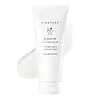What's inside
What's inside
 Key Ingredients
Key Ingredients

 Benefits
Benefits

 Concerns
Concerns

No concerns
 Ingredients Side-by-side
Ingredients Side-by-side

Water
Skin ConditioningSodium Cocoyl Glutamate
CleansingTea-Cocoyl Glutamate
CleansingGlycerin
Humectant1,2-Hexanediol
Skin ConditioningPropanediol
SolventGuar Hydroxypropyltrimonium Chloride
Skin ConditioningSimmondsia Chinensis Seed Oil
EmollientCamellia Japonica Flower Extract
EmollientAloe Ferox Leaf Extract
Skin ConditioningBioflavonoids
Skin ConditioningBrassica Oleracea Italica Extract
AstringentSodium Hyaluronate
HumectantBeta-Glucan
Skin ConditioningBiosaccharide Gum-1
HumectantPortulaca Oleracea Extract
Skin ConditioningCitrus Aurantium Dulcis Peel Oil
MaskingAnthemis Nobilis Flower Oil
MaskingDisodium EDTA
Water, Sodium Cocoyl Glutamate, Tea-Cocoyl Glutamate, Glycerin, 1,2-Hexanediol, Propanediol, Guar Hydroxypropyltrimonium Chloride, Simmondsia Chinensis Seed Oil, Camellia Japonica Flower Extract, Aloe Ferox Leaf Extract, Bioflavonoids, Brassica Oleracea Italica Extract, Sodium Hyaluronate, Beta-Glucan, Biosaccharide Gum-1, Portulaca Oleracea Extract, Citrus Aurantium Dulcis Peel Oil, Anthemis Nobilis Flower Oil, Disodium EDTA
Water
Skin ConditioningButylene Glycol
HumectantHelianthus Annuus Seed Oil
EmollientGlycerin
HumectantSqualane
EmollientMacadamia Ternifolia Seed Oil
EmollientPolyglyceryl-3 Methylglucose Distearate
EmulsifyingCaprylic/Capric Triglyceride
MaskingCetearyl Alcohol
EmollientGlyceryl Stearate Se
EmulsifyingSimmondsia Chinensis Seed Oil
EmollientHydrolyzed Hyaluronic Acid
HumectantSodium Hyaluronate
HumectantCeramide NP
Skin ConditioningPhytosphingosine
Skin ConditioningAcetyl Hexapeptide-8
HumectantCentella Asiatica Extract
CleansingAmmonium Acryloyldimethyltaurate/Vp Copolymer
Caprylyl Glycol
EmollientPanthenol
Skin ConditioningAllantoin
Skin ConditioningOctyldodecanol
EmollientCaprylhydroxamic Acid
Disodium EDTA
Xanthan Gum
Emulsifying1,2-Hexanediol
Skin ConditioningBisabolol
MaskingDipotassium Glycyrrhizate
HumectantEthylhexylglycerin
Skin ConditioningWater, Butylene Glycol, Helianthus Annuus Seed Oil, Glycerin, Squalane, Macadamia Ternifolia Seed Oil, Polyglyceryl-3 Methylglucose Distearate, Caprylic/Capric Triglyceride, Cetearyl Alcohol, Glyceryl Stearate Se, Simmondsia Chinensis Seed Oil, Hydrolyzed Hyaluronic Acid, Sodium Hyaluronate, Ceramide NP, Phytosphingosine, Acetyl Hexapeptide-8, Centella Asiatica Extract, Ammonium Acryloyldimethyltaurate/Vp Copolymer, Caprylyl Glycol, Panthenol, Allantoin, Octyldodecanol, Caprylhydroxamic Acid, Disodium EDTA, Xanthan Gum, 1,2-Hexanediol, Bisabolol, Dipotassium Glycyrrhizate, Ethylhexylglycerin
Ingredients Explained
These ingredients are found in both products.
Ingredients higher up in an ingredient list are typically present in a larger amount.
1,2-Hexanediol is a synthetic liquid and another multi-functional powerhouse.
It is a:
- Humectant, drawing moisture into the skin
- Emollient, helping to soften skin
- Solvent, dispersing and stabilizing formulas
- Preservative booster, enhancing the antimicrobial activity of other preservatives
Disodium EDTA plays a role in making products more stable by aiding other preservatives.
It is a chelating agent, meaning it neutralizes metal ions that may be found in a product.
Disodium EDTA is a salt of edetic acid and is found to be safe in cosmetic ingredients.
Learn more about Disodium EDTAGlycerin is already naturally found in your skin. It helps moisturize and protect your skin.
A study from 2016 found glycerin to be more effective as a humectant than AHAs and hyaluronic acid.
As a humectant, it helps the skin stay hydrated by pulling moisture to your skin. The low molecular weight of glycerin allows it to pull moisture into the deeper layers of your skin.
Hydrated skin improves your skin barrier; Your skin barrier helps protect against irritants and bacteria.
Glycerin has also been found to have antimicrobial and antiviral properties. Due to these properties, glycerin is often used in wound and burn treatments.
In cosmetics, glycerin is usually derived from plants such as soybean or palm. However, it can also be sourced from animals, such as tallow or animal fat.
This ingredient is organic, colorless, odorless, and non-toxic.
Glycerin is the name for this ingredient in American English. British English uses Glycerol/Glycerine.
Learn more about GlycerinThis oil comes from the seeds of the desert shrub called Jojoba. It is more commonly known as jojoba oil, a non-comedogenic oil.
Jojoba oil does not contain fragrance and has many fatty-acids, making it a great soothing ingredient.
It also contains Vitamin E, a great moisturizing ingredient. Vitamin E is also an antioxidant and protects your skin against oxidative damage.
This ingredient humectant properties, meaning it helps draw moisture from the air. This helps keep your skin hydrated.
While jojoba has antibacterial properties, it is only able to kill some strains of bacteria.
Studies also show it helps in wound healing. In fact, Indigenous cultures have used jojoba as a moisturizer and to help treat burns for centuries.
Fun fact: Jojoba oil similar to natural human skin sebum, so it has a great effect on dry skin. It is also promising with helping to regulate sebum production.
Due to its fatty acid content, Jojoba oil may not be fungal acne safe. We recommend speaking with a professional if you have any concerns.
Learn more about Simmondsia Chinensis Seed OilSodium Hyaluronate is hyaluronic acid's salt form. It is commonly derived from the sodium salt of hyaluronic acid.
Like hyaluronic acid, it is great at holding water and acts as a humectant. This makes it a great skin hydrating ingredient.
Sodium Hyaluronate is naturally occurring in our bodies and is mostly found in eye fluid and joints.
These are some other common types of Hyaluronic Acid:
Learn more about Sodium HyaluronateWater. It's the most common cosmetic ingredient of all. You'll usually see it at the top of ingredient lists, meaning that it makes up the largest part of the product.
So why is it so popular? Water most often acts as a solvent - this means that it helps dissolve other ingredients into the formulation.
You'll also recognize water as that liquid we all need to stay alive. If you see this, drink a glass of water. Stay hydrated!
Learn more about Water